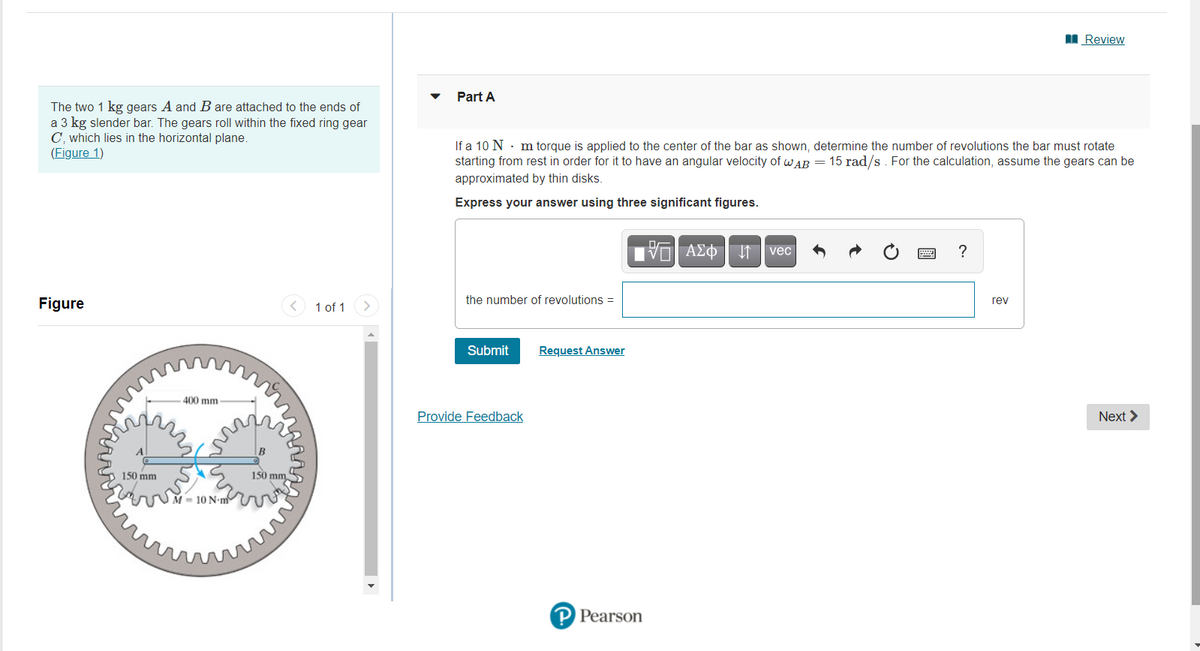Part A The two 1 kg gears A and Bare attached to the ends of a 3 kg slender bar. The gears roll within the fixed ring gear C. which lies in the horizontal plane. (Figure 1) If a 10 N · m torque is applied to the center of the bar as shown, determine the number of revolutions the bar must rotate starting from rest in order for it to have an angular velocity of w AR = 15 rad/s. For the calculation, assume the gears can be approximated by thin disks. Express your answer using three significant figures. Vol AEO vec ? Figure the number of revolutions = rev 1 of 1 > Submit Request Answer Provide Feedback Next > 150 mm 150 mm 10 N-1
Part A The two 1 kg gears A and Bare attached to the ends of a 3 kg slender bar. The gears roll within the fixed ring gear C. which lies in the horizontal plane. (Figure 1) If a 10 N · m torque is applied to the center of the bar as shown, determine the number of revolutions the bar must rotate starting from rest in order for it to have an angular velocity of w AR = 15 rad/s. For the calculation, assume the gears can be approximated by thin disks. Express your answer using three significant figures. Vol AEO vec ? Figure the number of revolutions = rev 1 of 1 > Submit Request Answer Provide Feedback Next > 150 mm 150 mm 10 N-1
Elements Of Electromagnetics
7th Edition
ISBN:9780190698614
Author:Sadiku, Matthew N. O.
Publisher:Sadiku, Matthew N. O.
ChapterMA: Math Assessment
Section: Chapter Questions
Problem 1.1MA
Related questions
Question
need help with engineering dynamics review problem
please be clear with your step by step solution so it is to understand

Transcribed Image Text:I Review
Part A
The two 1 kg gears A and B are attached to the ends of
a 3 kg slender bar. The gears roll within the fixed ring gear
C, which lies in the horizontal plane.
(Figure 1)
If a 10 N · m torque is applied to the center of the bar as shown, determine the number of revolutions the bar must rotate
starting from rest in order for it to have an angular velocity of WAR = 15 rad/s. For the calculation, assume the gears can be
approximated by thin disks.
Express your answer using three significant figures.
TVol AEO n vec
?
the number of revolutions =
Figure
rev
1 of 1
Submit
Request Answer
400 mm
Provide Feedback
Next >
B
150 mm
150 mm
10 N-m
Pearson
Expert Solution
This question has been solved!
Explore an expertly crafted, step-by-step solution for a thorough understanding of key concepts.
This is a popular solution!
Trending now
This is a popular solution!
Step by step
Solved in 2 steps with 1 images

Knowledge Booster
Learn more about
Need a deep-dive on the concept behind this application? Look no further. Learn more about this topic, mechanical-engineering and related others by exploring similar questions and additional content below.Recommended textbooks for you

Elements Of Electromagnetics
Mechanical Engineering
ISBN:
9780190698614
Author:
Sadiku, Matthew N. O.
Publisher:
Oxford University Press

Mechanics of Materials (10th Edition)
Mechanical Engineering
ISBN:
9780134319650
Author:
Russell C. Hibbeler
Publisher:
PEARSON

Thermodynamics: An Engineering Approach
Mechanical Engineering
ISBN:
9781259822674
Author:
Yunus A. Cengel Dr., Michael A. Boles
Publisher:
McGraw-Hill Education

Elements Of Electromagnetics
Mechanical Engineering
ISBN:
9780190698614
Author:
Sadiku, Matthew N. O.
Publisher:
Oxford University Press

Mechanics of Materials (10th Edition)
Mechanical Engineering
ISBN:
9780134319650
Author:
Russell C. Hibbeler
Publisher:
PEARSON

Thermodynamics: An Engineering Approach
Mechanical Engineering
ISBN:
9781259822674
Author:
Yunus A. Cengel Dr., Michael A. Boles
Publisher:
McGraw-Hill Education

Control Systems Engineering
Mechanical Engineering
ISBN:
9781118170519
Author:
Norman S. Nise
Publisher:
WILEY

Mechanics of Materials (MindTap Course List)
Mechanical Engineering
ISBN:
9781337093347
Author:
Barry J. Goodno, James M. Gere
Publisher:
Cengage Learning

Engineering Mechanics: Statics
Mechanical Engineering
ISBN:
9781118807330
Author:
James L. Meriam, L. G. Kraige, J. N. Bolton
Publisher:
WILEY